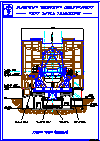The VLT 8.2-meter Unit Telescopes
Overview
The ESO Very Large Telescope consists of an array of four 8-meter telescopes which can work independently or in combined mode. In this latter mode the VLT provides the total light collecting power of a 16 meter single telescope. The telescopes may also be used in interferometric mode providing high resolution imaging. The useful wavelength range extends from the near UV up to 25 µm in the infrared. A schematic view of one unit telescope of the VLT giving a definition of the main telescope components is shown below.
 Side view Side view |
 Front view Front view |
Description
The unit telescope has alt-azimuth mount. In such a mount the telescope tube moves around a horizontal axis called elevation axis. The two bearings which support the tube are mounted on a fork rotating around a vertical axis, called azimuth axis, thus allowing for pointing over the entire sky. The telescope tube itself consists of a steel structure supporting at the bottom the primary mirror (M1) in its cell, and at the top the M2 Unit by means of metallic beams called "spiders". In a picture of the unit telescope, erected in December 1995 in Milan for testing purposes, the structure is nicely visible.
Enclosure
Each Telescope is protected from the external environment by an enclosure. The enclosure also provides access for operation and maintenance to certain areas of the telescope and a protection against the wind during observation. The telescope is mounted on a concrete foundation, the telescope pier.
Optical Layout
The VLT optical layout is of the Ritchey-Chretien type. The VLT can operate in either Cassegrain, Nasmyth or Coudé focus. The stellar light is collected by the primary mirror (M1), concentrated by the combination of the primary and the secondary mirror (M2) either directly to the Cassegrain focus located below the primary or to one of the two Nasmyth focii. The Coudé focus is obtained by transferring one Nasmyth focus to another location in the telescope basement by means of a relay system. From the Coudé focus the light can be sent to the combination mode focus or to the interferometric focus.
When changing between Cassegrain and Nasmyth/coudé operation, the curvature of M1 must be changed (active optics) and the secondary mirror must be refocused.
Astronomical Instruments
At the Nasmyth foci as well as below the main mirror (the Cassegrain focus) astronomical instruments are to be mounted. These foci are accessible from the Nasmyth platforms and from the azimuth platform at the base of the telescope, named the fork base floor. For maintenance the complete main mirror unit weighing about 50 tons is removed from the telescope and transported over the fork base floor out of the enclosure.
Active Optics
The Very Large Telescope uses active optics.The optical quality of the image is continually monitored by an image analyser using a reference star and the contributions of the various optical aberrations (defocus, astigmatism, coma, etc.) are computed. To achieve the best optical quality, discrete correction commands are given to the primary mirror support system, controlling the shape of the thin flexible M1, and to the M2 Unit, which controls the position of the M2 mirror along 5 degrees of freedom, namely one for focusing, two for centering, and two for pointing. The M2 mirror itself is configured as a rigid lightweight convex hyperboloid.
Astronomical Instruments
Various astronomical instruments are mounted at the Nasmyth foci as well as below the main mirror (the Cassegrain focus). These foci are accessible from the Nasmyth platforms and from the azimuth platform at the base of the telescope, named the fork base floor. For maintenance the complete main mirror unit weighing about 50 tons is removed from the telescope and transported over the fork base floor out of the enclosure.
Sky Accessibility
Maps are available to describe the sky accessible by each UT without vignetting by the dome of another UT.
Performance
The performance of the UTs in terms of pointing and tracking ensures optimal conditions for the vast majority of observations.
Table of Content
- The VLT 8.2-m Unit Telescope
- VLT Environmental Specifications
- The VLT primary mirrors
- The VLT Primary Mirror Cooling System
- The Secondary Mirror, M2 Unit
- The M1 Cell and M3 Tower
- The VLT Active Optics System
- The VLT Adapter-Rotators
- VLT Cassegrain Adapter-Rotators
- VLT Nasmyth Adapter-Rotator
- Very Large Telescope Enclosure
- VLT Technical CCD System
- Coating Unit
- Sky Accessibility
- UT Performance
